
|
|
|
|
BY: SUN STAFF
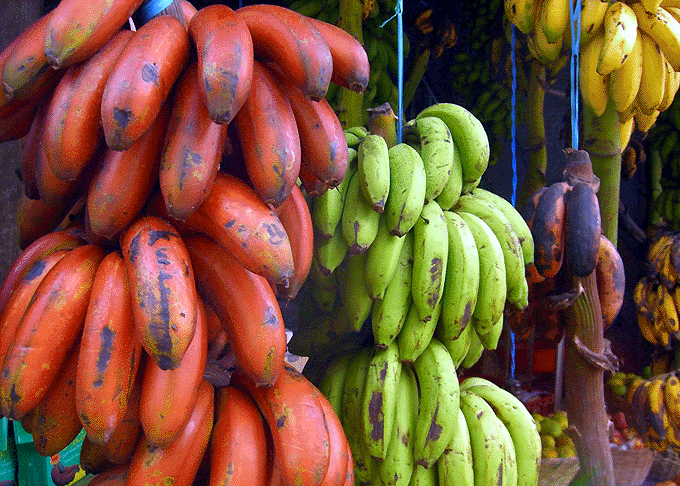
Jul 18, 2016 — CANADA (SUN) — A journey through India: border to border, bhoga to prasadam. Today's segment of the Prasadam series features a foodstuff that is known and loved the world over – Bananas! This ubiquitous fruit has been eaten for thousands of years, and is a staple bhoga item in temples across India. Known by many names – Kela, Nendran, Nenthra pazham, Hara kela and Kachcha Kela (green bananas), they come in a wide range of sizes, shapes and colors, each with its own distinctive flavor and texture. The wonderful dishes that can be prepared with bananas are so great in number we'll only manage to cover a small percentage… 'the tip of banana', if you will.
Since ancient times, bananas have been a primary domesticated food crop for subsistence farmers throughout the wet tropics and subtropics, from Southeast Asia to Asia, Africa, and the Pacific. While bananas are an important commercial export crops, 87% of banana production is for local consumption, which reflects how highly they're valued locally. All edible banana fruits are produced by plants belonging to the genus Musa, which is not actually a tree, but rather a very large herbaceous plant. The banana is found all the way north in Nepal, in the mountainous regions of southern China, and throughout Indonesia. India marks the western limit, except for the East African coast. No wild Musas are found in the Americas, but many varieties have been imported for commercial growing. Bananas are believed to have originated around Malaysia, traveling to India from there. Their presence in India is mentioned in Buddhist Pali writings from the 6th century B.C. Bananas are thought to have moved into South India during eras when the climate was particularly humid. Arab and Greek writers who happened to taste banana in India dubbed it the 'Fruit of Paradise'. Alexander the Great is thought to have been the first European to taste the fruit in India, introducing it into the Western world. Banana plantations in China are recorded from as early as 200 B.C. Bananas are enjoyed by nearly everyone, from babies to the aged, being very soft and easy to eat and digest. They're also one of the cheapest, tastiest and most nutritious fruits available. Packed in their own hygienic skin, they're easy to harvest, transport and store. Taken with milk, the banana constitutes an almost complete diet.
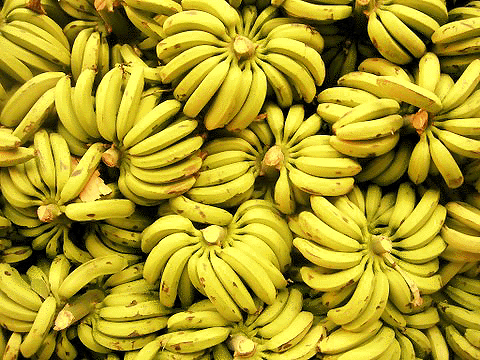
There are hundreds of varieties of bananas available, from tiny finger-sized fruits to great fruits as big as a man's arm. Ripe bananas come in all colors, from green to yellow, red, and purple. Given their high nutritional value, wide range of natural distribution and the vast number of ways they can be prepared and enjoyed, it's not surprising that bananas are mentioned in the Vedas. In fact, they're one of the most auspicious foodstuffs of all, and are a regular bhoga item, often combined with milk products for offering to the deities. The leaves of the Banana are used in puja and sacrifices, and have been worshipped much like Tulsi in some religious communities. We find many references to bananas in Krsna lila literature and throughout Sri Caitanya-caritamrta. Not surprisingly, bananas were considered a staple food by Srila Prabhupada, and were included in the recommended diet he gave for temple devotees. In the menu he instructed all the temples to follow every day, bananas are found twice -- at the start and finish of the day. For breakfast, Srila Prabhupada recommended a simple farina cereal with nuts and raisins; hot milk or yogurt in the summertime; chickpeas (raw and soaked overnight); raw ginger root; and bananas, oranges and apples. Before taking rest, he recommended steaming hot milk and bananas be taken. The references to bananas in Caitanya-caritamrta are as sweet and relishable as the fruits themselves. In Madhya lila (3:38-136) we find the story of Advaita Acarya, inviting Lord Caitanya to his home to take prasada. In order to circumvent the sannyasi's proper aversion to opulent foods, Sri Advaita told the Lord that he had only cooked a palmful of rice and simple vegetables. But in fact, Advaita Acarya's wife was busy preparing many excellent foodstuffs for Mahaprabhu. As we noted in our last Prasadam series on Leaves, the banana leaf is favored for use as a serving plate. From Madhya lila 3.42: "All the prepared food was divided into three equal parts. One part was arranged on a metal plate for offering to Lord Krsna. Of the three divisions, one was arranged on a metal plate, and the other two were arranged on plantain leaves. These leaves were not bifurcated, and they were taken from a banana tree that held at least thirty-two bunches of bananas. The two plates were filled very nicely with the kinds of food described below. The cooked rice was a stack of very fine grains nicely cooked, and in the middle was yellow clarified butter from the milk of cows. Surrounding the stack of rice were pots made of the skins of banana trees, and in these pots were varieties of vegetables and mung dal." Srila Kaviraja Gosvami goes on to describe the many wonderful preparations offered to the Lord by Advaita Acarya: "Among the cooked vegetables were patolas, squash, manakacu and a salad made with pieces of ginger and various types of spinach. There was sukhta, bitter melon mixed with all kinds of vegetables, defying the taste of nectar. There were five types of bitter and pungent sukhtas. Amongst the various vegetables were newly grown leaves of nimba trees fried with eggplant. The fruit known as patola was fried with phulabadi, a kind of dal preparation first mashed and then dried in the sun. There was also a preparation known as kusmanda-manacaki. The preparation made with coconut pulp mixed with curd and rock candy was very sweet. There was a curry made of banana flowers and squash boiled in milk, all in great quantity. There were small cakes in sweet and sour sauce and five or six kinds of sour preparations. All the vegetables were so made that everyone present could take prasada. There were soft cakes made with mung dal, soft cakes made with ripe bananas, and soft cakes made with urad dal. There were various kinds of sweetmeats, condensed milk mixed with rice cakes, a coconut preparation and every kind of cake desirable. [ ] Besides the other preparations, there were chipped rice made with milk and mixed with bananas, and also white squash boiled in milk. Indeed, it is not possible to describe all the preparations that were made. In two places there were earthen pots filled with another preparation made with yogurt, sandesa [a sweetmeat made with curd] and banana. I am unable to describe it all." 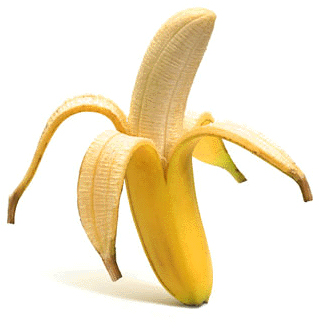
As we see in the above descriptions, many of the preparations made with bananas can be done very simply. The fruit is so tasty, and has such a nice texture, that it becomes an opulent foodstuff when combined with milk products, rice, sweeteners and spice, or cooked into vegetable dishes. Making a "preparation" of bananas can be as simple as slicing them into milk, sprinkling them with sugar or spice, or just roasting them whole in their skins. Srila Prabhupada was very fond of sliced bananas in milk, which go nicely with a little nutmeg, cinnamon or cardamom. Steamed Banana is another easy prep, made by cutting the banana, in its skin, into pieces. Steam them for five minutes, while you're making a syrup of jaggery and water. Pour the caramelized syrup over the steamed fruit, and offer. Grilled bananas couldn't be easier to prepare. They're a beautiful dish to offer Sri Krsna, and they're always enjoyed by the devotees.
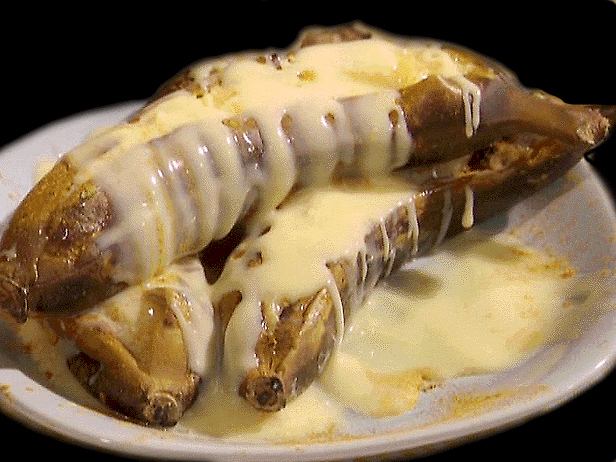
Grilled Bananas in Kheer
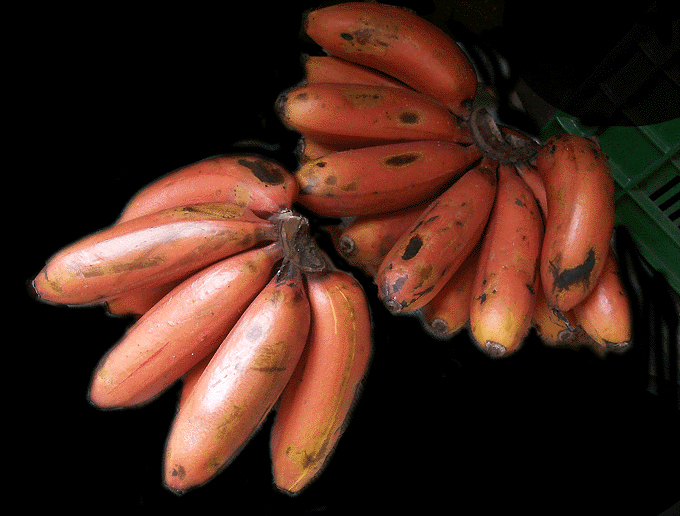
There are also many complex preparations made with bananas, as we'll see in the segments to follow. Some of these are recorded in an ancient reference from Kannada literature, the Supa-sastra, or ' Science of Cooking'. This manual memorializes the many excellent qualities of bananas. The Supa-sastra was composed by Mangarasa around 1509 A.D. The author wrote the manuscript for the benefit of house-wives. Divided into six chapters, the fourth chapter includes twenty-five varieties of raw banana, along with preparations from both banana stems and flowers. Among the many exotic preparations included in Supa-sastra are five different varieties of Banana Stem Curry, a delicious high-fiber dish made from the soft, white inner stem of the Banana. Generally enjoyed only when a Banana tree is cut down or felled by stormy weather, the dish is relished for its excellent taste and healthful qualities. Banana stem curries are prepared by thinly slicing the stem and cooking it in milk, tamarind juice, and with added pulses and spices. Known as Vaazhai Thandu in Tamil, the inner stem of the Banana is used in this nice South Indian recipe, Tamil Mor Kootu:
Ingredients:
Vaazhai Thandu (inner stem of Banana) Remove the outer skin of the thandu and cut the inner stem into round slices, and julienne some into long, thin pieces if you like. Cook the cut pieces in water with the turmeric powder and 1/4 tsp salt. After the vegetable has cooked, drain off the excess water. Make a paste with the chilly, coconut and cumin and add to the buttermilk. Add the remaining salt and the cooked vegetable and heat it up for 3 minutes. Garnish with spluttered mustard seeds.
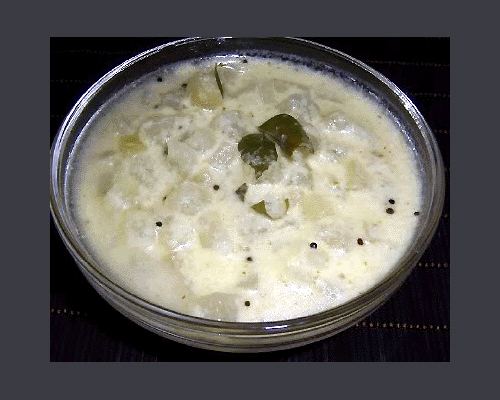
Tamil Mor Kootu In the segments to follow, we'll offer recipes for many other types of preparations featuring bananas, ranging from sweets to breads, chutneys, savouries, and sabjis.
| |